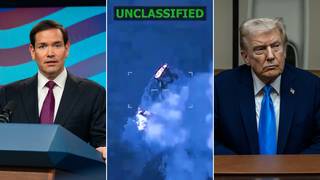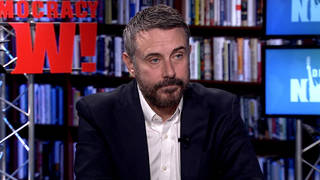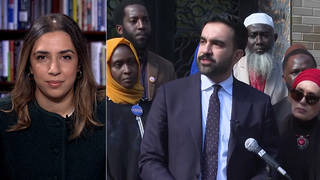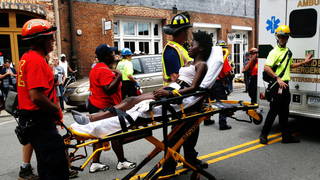
Guests
- Bree Newsome Bassartist and activist. Following the massacre of nine African-American parishioners by a white supremacistin Charleston in June 2015, Bree scaled a flagpole at the South Carolina state Capitol and removed the Confederate flag.
Bree Newsome sparked a national debate in 2015 on Confederate monuments and symbols and their place in modern American society when she scaled a 30-foot flagpole in South Carolina and removed the Confederate flag from state Capitol grounds. Her action followed the massacre of nine African-American parishioners by a white supremacist at a Charleston church in South Carolina. As police yelled for her to come down, she grabbed the Confederate flag and said, “You come against me with hatred … I come against you in the name of God. This flag comes down today.” Footage of the event went viral and was seen around the world. The next month, state legislators voted to remove the Confederate flag permanently, following mounting pressure. We speak with artist and activist Bree Newsome about renewed efforts around the country to remove Confederacy symbols following this weekend’s deadly rally in Charlottesville, Virginia—where white nationalists and members of “alt-right” groups had gathered to protest the city’s decision to remove a statue of Confederate Gen. Robert E. Lee from a downtown park.
Transcript
AMY GOODMAN: “Stay Strong” by Bree Newsome. This is Democracy Now!, democracynow.org, The War and Peace Report. I’m Amy Goodman, with Juan González.
JUAN GONZÁLEZ: It was in 2015, following the massacre of nine African-American parishioners on June 17th in Charleston, [South] Carolina, by white supremacist Dylann Roof, that a young woman scaled a 30-foot flagpole on the state Capitol grounds in Columbia, South Carolina. As police officers shouted at her to come down, Bree Newsome shimmied to the top of the flagpole, took the Confederate flag in her hand and said, “You come against me with hatred … I come against you in the name of God. This flag comes down today!”
BREE NEWSOME: You come against me with hatred and oppression and violence. I come against you in the name of God. This flag comes down today!
AMY GOODMAN: Bree Newsome recited Psalm 27 and the Lord’s Prayer as she brought the flag down. Her action went viral, as she and her ally, Jimmy Tyson, were taken off to jail. The video was seen around the world. Bree Newsome was arrested as soon as she touched ground. She and Tyson, who stood at the bottom of the flagpole as she climbed up, both were charged with defacing state property, later released on bail. Under mounting pressure, South Carolina legislators voted to remove the Confederate flag permanently the following month.
We go now to Charlotte, North Carolina, where we’re joined once again by Bree Newsome, an artist, singer, activist.
Bree, welcome back to Democracy Now!
BREE NEWSOME: Thank you for having me.
AMY GOODMAN: Your thoughts on what happened in Charlottesville? And reflecting back on your actions, listening to Takiyah, as she heads off to court today, facing felony charges for taking down a monument, your thoughts?
BREE NEWSOME: Yes, well, I think—first of all, thank you for having me back.
I think one of the most dangerous things that could happen in this moment would be for us to analyze the events on Saturday in [Charlottesville] in a bubble or in a vacuum, where we are only looking at, you know, what happened in those few hours in Charlottesville, and not viewing this as the culmination of several moments leading up to this. You know, if you’ll recall, back in 2015, when I participated in the action to lower the flag is South Carolina, that, of course, was also coming in the wake of a white supremacist terrorist attack. And we’ve had a surge in both white supremacist groups and white supremacist terrorist attacks since the election of Obama in 2008. And the election of Donald Trump, a white nationalist, in response to that election, really represents a racist backlash. So I think that Takiyah was absolutely right in terms of, you know, saying that there is a definite growing fascist movement in this nation, and then you’re also seeing a reactionary movement in response to that.
JUAN GONZÁLEZ: And what is your response when you hear President Trump try to equate violence of the left and violence of the right?
BREE NEWSOME: Well, that’s an age-old, you know, kind of racist technique, right? So, to create a false equivalency between things. Even during the Civil War, you had slave owners arguing that what the North was trying to do was to enslave them, you know, that the North was infringing upon their rights by demanding that slavery be ended. So, what Donald Trump was doing yesterday was nothing new, you know, creating this false equivalency between both sides.
When we look at the footage that came out of Charlottesville, and then you compare that to the footage that we saw in Ferguson, where people were being tear-gassed by the police while standing in their front yards—and again, you have to remember, in situations like Ferguson and Baltimore and Charlotte, these were clashes that came in the wake of police killings. These were communities that were protesting police violence, and you had the police using all of their force to respond. Now, when you compare that to Charlottesville, here the situation was the city voted to remove a Confederate monument, and then you had white nationalists and fascist groups from around the nation descend onto the city. And then you saw the fascists show up with weapons, with guns, with shields, clearly coming prepared for violent clashes. And you saw a slow response from the police force.
So, to create any kind of false equivalency here ignores not only the current imbalance of power, where we have really a white nationalist representative in the White House—and it’s clear from when you see the comments from members of these white nationalist groups that that’s certainly how they view Trump. They certainly view him as an ally in the White House. But we also have a long history of white supremacist power structures. And so, there is—while it may be true on its face that there were—that there was violence and violent clashes on both sides, there is an absolute imbalance in power, both presently and historically, that has to be acknowledged.
AMY GOODMAN: So, let’s go to Donald Trump Tuesday at this bellicose, angry news conference he held in the lobby of his residence at Trump Tower, defending his decision to wait two days before placing blame on white supremacists for the deadly violence in Charlottesville, Virginia, last Saturday. During the news conference, the president attacked the counterprotesters, repeating his earlier claim that he had made on Saturday, when he talked about both sides being blamed for the violence.
REPORTER 1: You said there was hatred, there was violence on both sides. Are the counterprotesters to blame—
PRESIDENT DONALD TRUMP: Well, I do think there’s blame—yes, I think there’s blame on both sides. You look at—you look at both sides, I think there’s blame on both sides. And I have no doubt about it, and you don’t have any doubt about it, either. And—and—
REPORTER 1: But only the Nazis—
PRESIDENT DONALD TRUMP: And—and if you reported it accurately, you would say.
REPORTER 2: One side killed a person. Heather Heyer died—
REPORTER 1: The neo-Nazis started this. They showed up in Charlottesville. They showed up in Charlottesville—
PRESIDENT DONALD TRUMP: Excuse me. Excuse me.
REPORTER 1: —to protest the removal of that statue.
PRESIDENT DONALD TRUMP: They didn’t put themselves down as neo—and you had some very bad people in that group. But you also had people that were very fine people, on both sides. You had people in that group—excuse me. Excuse me. I saw the same pictures as you did. You had people in that group that were there to protest the taking down of, to them, a very, very important statue and the renaming of a park, from Robert E. Lee to another name.
REPORTER 2: So, do you support white nationalists then?
REPORTER 1: George Washington and Robert E. Lee are not the same, Mr. President.
PRESIDENT DONALD TRUMP: Well, no, George Washington was a slave owner. Was George Washington a slave owner? So, will George Washington now lose his status? Are we going to take down—excuse me. Are we going to take down—are we going to take down statues to George—how about Thomas Jefferson? What do you think of Thomas Jefferson? You like him?
REPORTER 1: I do love Thomas Jefferson.
PRESIDENT DONALD TRUMP: OK, good. Are we going to take down the statue? Because he was a major slave owner. Now, are we going to take down his statue? So, you know what? It’s fine. You’re changing history. You’re changing culture. And you had people—and I’m not talking about the neo-Nazis and the white nationalists, because they should be condemned totally. But you had many people in that group, other than neo-Nazis and white nationalists, OK? And the press has treated them absolutely unfairly. Now, in the other group also, you had some fine people, but you also had troublemakers. And you see them come with a—with the black outfits and with the helmets and with the baseball bats. You’ve got a—you had a lot of bad—you had a lot of bad people in the other group, too.
REPORTER 1: Who were the good people?
REPORTER 2: Who has the press treated unfairly, sir? I’m sorry. I just don’t understand what you were saying. You were saying the press has treated white nationalists unfairly? I just don’t understand what you were saying.
PRESIDENT DONALD TRUMP: No, no. There were people in that rally—and I looked—the night before, if you look, they were people protesting, very quietly, the taking down of the statue of Robert E. Lee.
AMY GOODMAN: Bree Newsome, that’s the president of the United States, the 45th president of the United States, speaking yesterday. On Saturday, he sounded like this. Then, on Monday, he read a teleprompter speech, under enormous pressure from his own party, from business leaders, from grassroots activists across the country, and read a speech where he said the names of white nationalists, neo-Nazis and KKK. He used those terms. But now, without that teleprompter, this is what he had to say. Your thoughts?
BREE NEWSOME: Well, off teleprompter, Trump is the real Trump. Twitter Trump is the real Trump. When we see him, you know, tweeting an image of the Trump train running over a person with the CNN logo across their face, I mean, that’s the accurate Trump.
I also definitely want to push back against this notion that there’s blame on both sides. There is absolutely not blame on both sides. I am quite familiar with the local organizers in Charlottesville. Several of them are clergy members. They had been organizing for several months around the issue of removing this Confederate monument, you know, organizing, going to their City Council meetings, and were successful in convincing the city to remove the statue. What then followed was that they became a target for white nationalist organizations nationwide. And, you know, this is not the first time that we’ve seen white nationalists descend on Charlottesville with torches, and there was also a Klan rally a couple months ago. So, the clergy were organizing in response to this threat that was being posed to their town by white nationalist organizations on a national scale. They had planned a counterprotest, a nonviolent counterprotest. They sent out a call across the nation for clergy to come and join them to, you know, stand in defiance of this planned white nationalist rally on Saturday, August 12th. They were holding a prayer meeting on Friday night, when white nationalists, carrying torches, surrounded the church. So they were—they were outside of the church shouting at people inside the church praying—clergy members, people of all ages, children. And then they marched over to the campus of UVA, where they also assaulted students, who were—who had surrounded the monument and were holding a banner. They were unarmed. They were standing in peace. They were standing with a message against racist violence. And they were descended upon and beat.
And again, there was no police response. There were no arrests made. Compare that to Ferguson, where you had 128 people arrested, where we saw images of families marching during the daytime and police in tanks pointing sniper rifles at them. I mean, again, I think that it is really dangerous for us to analyze the events on Saturday without taking a broader view of historical context, both recent and, you know, of course, within the context of the past hundred years, where civil rights—the Civil Rights Act, the Voting Rights Act, these things are only about 50-or-so-plus years old. This is very, very recent history.
JUAN GONZÁLEZ: Bree, I wanted to ask you—there was another remark made yesterday that didn’t get quite as much as attention. It was by the Marine commandant, General Robert Neller, who said—he put out a tweet saying there’s “no place for racial hatred or extremism in [the U.S. Marine Corps]. Our core values of Honor, Courage, and Commitment frame the way Marines live and act.” It may have been in response to the fact that there was a recent Marine recruiter who was involved in the protest in Charlottesville, but it also speaks to the issue that the U.S. military, being so heavily integrated, with so many African Americans and Latino soldiers, the generals must be concerned that if this—the increasing divisions in the society spread to the military ranks, there may be problems even within the U.S. military. I’m wondering your thoughts on that.
BREE NEWSOME: Well, yes, I think that is something that they absolutely should be concerned about and should be proactive in addressing. I mean, of course, you know, we know that the military has its own history of racial segregation and then racial integration. We have a long history of African Americans serving in wars and then returning home only to face segregation and hatred and inequality in the country that they fought for. And then, most recently, of course, we had Trump making this announcement about banning trans servicemembers. So, you know, in a time where the commander-in-chief is not really acting in his role and is not being a uniter, is not providing any kind of moral leadership or any kind of clear vision for the country that is positive, it increasingly falls on leaders in other sectors of the government—not just in the government, but on a local level and on average everyday people, to fill in, to stand in and to take that moral leadership and to provide that moral clarity. So I hope that the military will be proactive in addressing these issues.
AMY GOODMAN: Particularly important given that James Fields, well, he left the Marines, after four months, earlier this year, and the white supremacist report that Juan was talking about, a white—a former marine who led a white supremacist group in the so-called Unite the Right rally that took place on Saturday. I want to turn to another white supremacist, Christopher Cantwell, speaking to Vice on the day after the Charlottesville protests.
CHRISTOPHER CANTWELL: The fact that nobody on our side died, I’d go ahead and call that points for us. The fact that none of our people killed anybody unjustly, I think, is a plus for us. And I think that we showed—we showed our rivals that we won’t be cowed.
ELLE REEVE: But the car that struck a protester, that’s unprovoked.
CHRISTOPHER CANTWELL: That’s not true, and you know that it’s not true. You’ve seen the video. So—
ELLE REEVE: I’ve seen a video.
CHRISTOPHER CANTWELL: Yeah.
ELLE REEVE: I don’t know much about it.
CHRISTOPHER CANTWELL: Oh, I understand that you’re—
ELLE REEVE: Though—can you describe what the video appears to show?
CHRISTOPHER CANTWELL: Well, OK. So, the video appears to show someone striking that vehicle, when these animals attacked him again, and he saw no way to get away from them except to hit the gas. And sadly, because our rivals are a bunch of stupid animals who don’t pay attention, they couldn’t just get out of the way of his car, and some—and some people got hurt. And that’s unfortunate.
ELLE REEVE: So you think it was justified.
CHRISTOPHER CANTWELL: I think it was more than justified. I can’t believe—the amount of restraint that our people showed out there, I think, was astounding.
ELLE REEVE: What do you think this means for the next “alt-right” protest?
CHRISTOPHER CANTWELL: I say it’s going to be really tough to top, but we’re up to the challenge.
ELLE REEVE: Wait, why?
CHRISTOPHER CANTWELL: Why?
ELLE REEVE: Tough to top? I mean, someone died.
CHRISTOPHER CANTWELL: I think that a lot more people are going to die before we’re done here, frankly.
AMY GOODMAN: White supremacist Christopher Cantwell, speaking to Vice the day after Heather Heyer was killed, her funeral today in Charlottesville. Bree Newsome, your response?
BREE NEWSOME: I mean, again, I just continue to emphasize to people that this is not new. This is a—this is part of a long history and a pattern of white supremacist terrorism in this country. I think part of what people are struggling right now—struggling with right now is recognizing that it is terrorism, for whatever reason. But the reality is that the greatest terrorist threat in the United States is and has always been from white nationalists and white supremacists.
Heather Heyer, her death is part of a tragic and long history of white allies who were standing with black activists fighting for justice, who lost their lives, who were killed by white supremacists. Of course, one of the most famous cases was the case of Chaney, Goodman and Schwerner, three civil rights workers who traveled to Mississippi in 1964 to register black citizens there to vote. And they went missing, and they were—their bodies were discovered several days later, and it, you know, became clear that they had been murdered by the Ku Klux Klan, working in collaboration with police.
You know, so, again, this whole question about, you know, is it terror, is it not terror, that is a question that should no longer be asked. It absolutely is terrorism, by every definition. Not only are these acts of violence that are intended to cause terror, but they are also politically informed. It is people using terrorism as a tactic to push an ideology. There is absolutely no moral difference between a white supremacist plowing his car into a crowd of unarmed protesters to advance an ideology and someone who is inspired by ISIS plowing their car into a crowd on a street in Germany for the same reasons, to drive home some ideology that they believe in. There’s no difference. It is terrorism. It should be labeled as such. It should be dealt with as such. It should be investigated as such.
Not only should, you know, people like Dylann Roof and the terrorists from Saturday be charged and prosecuted, but there needs to be an investigation of these networks. How far do they go? How far into the power structure do they reach? We know that one of the closest advisers to the president runs a—or used to run a news platform that he described as being a platform for the “alt-right.” The “alt-right,” that term was coined by Richard Spencer, who we saw on Saturday pressing up against the police line with shields. I mean, it just reaches a certain point where, you know, asking certain questions are ridiculous, and it’s just time to deal in reality.
AMY GOODMAN: Bree Newsome, we want to thank you for being with us. Bree brought down the Confederate flag on the South Carolina State House a day after the mass funeral for the nine African-American parishioners who were murdered by the white supremacist at the Emanuel AME Church, Dylann Roof. Ultimately, the flag was put back up, but then brought down once again under general demand. The governor at the time was Nikki Haley. Years before, when she was asked about bringing down the Confederate flag, she said no business leaders had called for that. Nikki Haley, the current U.S. ambassador to the United Nations.
This is Democracy Now!, democracynow.org. When we come back, we look at antifa, the anti-fascists on the streets of Charlottesville and all over the United States and different places around the world. Stay with us.












Media Options